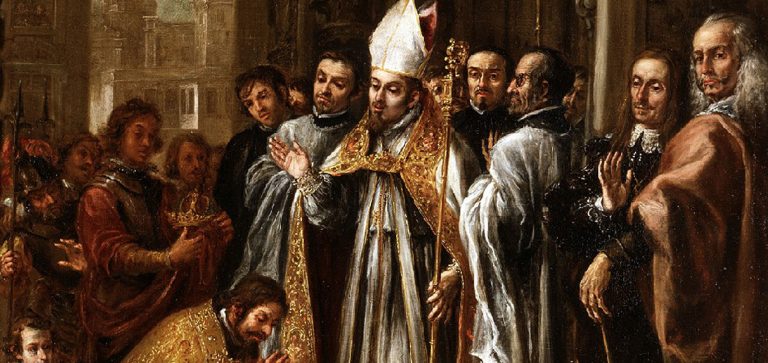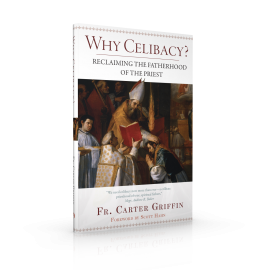By Fr. Carter Griffin
Fr. Carter Griffin is a priest of the Archdiocese of Washington. Since 2011 he has been engaged in the formation of seminarians at Saint John Paul II Seminary in Washington, DC. Fr. Griffin is a graduate of Princeton University and a former line officer in the United States Navy. He is the author of Why Celibacy?: Reclaiming the Fatherhood of the Priest.

Before Christ, sterility was seen either as a curse or as a condition for God to reveal his power by transforming it into fruitfulness. The patriarch Abram, a Hebrew name meaning “Exalted Father,” was still childless at the age of a hundred when he received an even more incongruous name: Abraham, meaning “Father of a Multitude of Nations.” As Scott Hahn observes, for a man of Abraham’s age without progeny, such a name must have provoked ridicule. “I’m sure the new name didn’t make life any easier for old Abraham,” Hahn remarks, “as he made his way past the cruelest of his gossipy neighbors.”
In time, though, God’s promise was fulfilled and Abraham’s physical and spiritual descendants did indeed flourish, even to our own day—even to us. Through God’s power, Abraham’s human sterility was charged with awesome fecundity, both natural and supernatural, and hence became an Old Testament trope that anticipates the fruitfulness of virginity in the New Covenant.
The first line of the New Testament, in fact, is a reference to the fruitfulness of Abraham. Jesus is called the “son of Abraham,” and by drawing to himself all the nations, Jew and Gentile alike, God fulfills his promise to Abraham and affirms the literal truth of his name. “Fruitful sterility” is therefore transformed in the New Testament into a “fruitful virginity,” consciously chosen, beginning with the virginity of Mary, Joseph, John the Baptist, and, above all, Jesus himself. One theologian identifies this shift in focus from the fruitfulness of the flesh to the fruitfulness of the spirit as one of the key “turning points” in salvation history.
In the Old Testament, Aquinas argues, it was necessary that the faithful generate physically in order to usher in the Messianic Age. “The counsel of practicing perpetual continence,” he continues, was therefore “reserved to the New Testament, when the faithful are multiplied by a spiritual generation.” Thus when Jesus extols those who “have made themselves eunuchs for the sake of the kingdom of heaven” and declares that he “who is able to receive this, let him receive it” (Matt 19:12), he is emphasizing its supernatural end, its fecundity in spiritual generation. Indeed, some verses later, Jesus affirms that those who have “left houses or brothers or sisters or father or mother or children or lands, for my name’s sake, will receive a hundredfold, and inherit eternal life” (Matt 19:29)—a “hundredfold,” which some authors attribute to the superabundant fruitfulness of virginal generativity.
It should be acknowledged that this scriptural support for the supernatural fruitfulness of celibacy is not a direct link to priestly ministry itself, as non-Catholic apologists readily point out. Neither do other Scriptural passages often cited in defense of celibacy include explicit references to ministry—for instance, St. Paul’s counsel to the Corinthians that “it is well” for the unmarried and widows “to remain single as I do” (1 Cor 7:8). Indeed, St. Paul’s injunctions to both Timothy and Titus that a bishop should be a “husband of one wife” (1 Tim 3:2; Titus 1:6) are often mentioned as definitive proof that ministry was not associated with celibacy in the apostolic age. Nonetheless, while conceding that the Church developed her understanding of celibate priesthood over time, it is by no means clear that these texts rule out early Christian adoption of ministerial celibacy or perpetual continence. After all, St. Paul also insists that a widow receiving Church support be the “wife of one husband” (1 Tim 5:9). Clearly, since she is a widow, St. Paul obviously cannot mean that she is currently married but rather that she has renounced any opportunity to marry again. Thus, St. Paul’s statements about bishops and deacons likely refer to their renunciation of remarriage if they are, or become, widowed. This, at any rate, was the Church’s interpretation of these passages at least from the time of Pope Siricius (fourth century) until modern times. What can be said definitively is that the ambiguous texts of St. Paul do not contradict his other clear statements to the Corinthians about the value of celibacy or the celibate witness and teaching of Jesus himself. They may even reinforce the historical claim that in the early Church perpetual continence was likely the norm for priests, including those married at the time of their ordination.
The practice of clerical celibacy grew rather than declined in the early centuries of the Church. The Council of Elvira (305) in Spain, for example, ratifying what was already an ancient practice, obliged complete continence for bishops, priests, and deacons. Synods, local councils, papal decrees, and even penitential books over the following centuries did the same. The Second Lateran Council (1139)—often erroneously cited as the beginning of obligatory celibacy for priests— merely restated, in response to rampant abuses, what had long been the practice of the Latin Church and declared invalid any marriage contracted by a cleric. The Eastern Church did not hold as stringently to the apostolic norm, though even in the Eastern Churches, for whom the Council of Trullo (691) permitted married clergy, ordination remained an impediment to marriage and the celibate norm was (and still is) maintained for bishops who possess the fullness of Holy Orders.
Through the years, the association of priestly celibacy with supernatural generativity was never entirely lost, though it did ebb and flow. The writings of early Christian authors—such as Origen, Pseudo-Jerome, Sts. Ephrem, Damasus, and Gregory the Great, and particularly Eusebius of Caesarea—make the point explicitly, as did later writers. The eleventh-century St. Peter Damian, for example, emphasized that the bishop’s celibacy reflects his “marriage” to the local Church, represented by the episcopal ring that Damian likened to a wedding ring.
In recent times the relationship between priestly celibacy and spiritual fatherhood has begun to emerge again more forcefully. Pope Pius XII, for instance, in his Apostolic Exhortation Menti Nostrae, drawing together the thought of Sts. Ambrose, John of Avila, Alphonsus Liguori, and John Bosco, taught that by the law of celibacy, “the priest, so far from losing the gift and duties of fatherhood, rather increases them immeasurably, for, although he does not beget progeny for this passing life of earth, he begets children for that life which is heavenly and eternal.”
The Second Vatican Council’s Decree on the Ministry and Life of Priests describes celibacy as “a source of spiritual fruitfulness in the world” and renders priests “better fitted for a broader acceptance of fatherhood in Christ.” Similarly, St. Paul VI, in his encyclical Sacerdotalis Caelibatus, remarks that the priest’s celibacy “inculcates in him, as a sign of a higher and greater fatherhood, a generosity and refinement of heart which offer a superlative enrichment.” St. John Paul II makes explicit the connection between celibacy and spiritual fatherhood in his Apostolic Exhortation Familiaris Consortio, in which he reminds the Church that, “in spite of having renounced physical fecundity, the celibate person becomes spiritually fruitful, the father and mother of many, cooperating in the realization of the family according to God’s plan.”
You Might Also Like

Priestly celibacy, some say, is an outdated relic from another age. Others see it as a lonely way of life.
But as Fr. Carter Griffin argues in Why Celibacy?: Reclaiming the Fatherhood of the Priest, the ancient practice of celibacy, when lived well, helps a priest exercise his spiritual fatherhood joyfully and fruitfully.